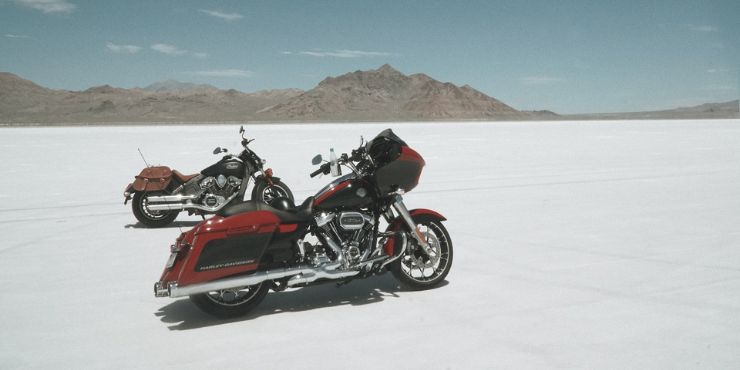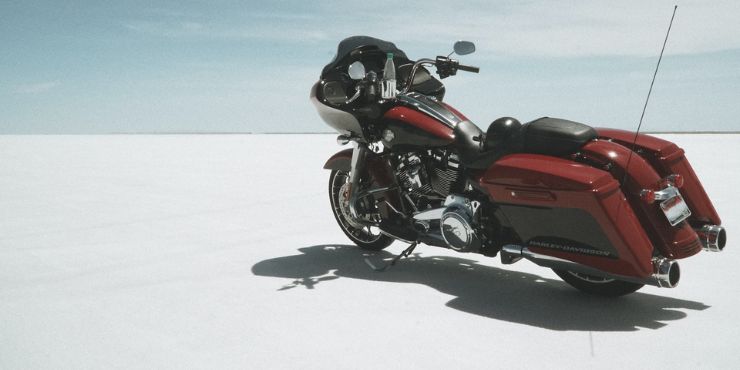Are you a Harley-Davidson biker ready to put your bike into hibernation, but don’t know how to winterize it? If so, then you’re definitely in the right place.
To winterize a Harley-Davidson, change the oil, fill the gas tank with fuel stabilizer, clean the bike thoroughly, and connect it to a battery tender. Store it in a dry, covered space and consider blocking off the exhaust to prevent moisture buildup.
In this article, you’ll get to know all about winterizing a Harley-Davidson bike, how to winterize Harley-Davidson bikes, common winterizing mistakes Harley-Davidson bikers make, and more. Continue reading to get all the answers that you’re looking for.
Winterizing a Harley-Davidson bike before hibernation
As the winters approach and motorcycling season winds down, it’ll be time for your bike to go into hibernation. For most bikers, the end of the fall marks the crucial time for maintenance. With the onset of winter, it’s the perfect time to tuck away your motorcycle, but not before winterizing it properly and effectively. Most bikers have their own little rituals and elaborate ways in which they winterize their bikes.
Moreover, Harley-Davidson also has more than 700 dealers across the United States to help you winterize your bike and store it safely until Spring. Many bikers see winter as the most viable time to make customizations or enhancements to their bike. They choose to drop off their bikes in the winter and pick up the transformed machine in the Spring.
How to winterize Harley-Davidson bikes
1. Freshen up the fluids
For starters, you’ll need to freshen up the fluids. This means you’ll have to refill the motor oil, brake, clutch, and coolant. However, it’ll depend on how long it has been since the last time you changed the fluids. If the last time was a month or so ago, and you’ve only driven a few hundred miles, you’ll need to stick to changing the oil.
The reason changing fluids regularly is essential is that they rack up contaminants from regular usage. It becomes corrosive over time and can easily destroy rubber seals.
2. Change the oil
The last thing that you’ll want is for your bike to sit idle all winter, filled to the brim with oil contaminated with sediments and solvents. It may not run at all if the bearings are corroded or damaged. Changing the oil is a simple yet vital step to take to avoid having to fork out money down the road.
3. Tenderize the battery
How exactly do you need to store your bike for winter? Some bikers recommended starting the bike the first week of winter and letting it run.
However, a much better solution would be to clean the battery’s electrodes and hook them to a better tender for the duration of the winter. Not only should you be using a battery tender during winter, but you should be using one all the time.
This helps in extending the longevity of the battery. A Harley-Davidson tender starts at around $29 and goes up to $129.
4. Check the tires
You might be wondering how long motorcycle tires last in storage. This will mostly depend on the respective tire gear going into storage and how your motorcycle is stored.
Aside from checking for even wear on the tires, make sure that you have enough tread remaining. Make sure that the tires aren’t worn out to the extent that the wear bars are exposed.
The proper tire inflation pressures will be listed in the owner’s manual and on the VIN label. You can also opt to put the bike on the front and rear stands, lifts, or dollies for keeping the motorcycle upright the entire winter. It’ll also relieve the pressure on the tires.
If you choose not to use a lift, move the motorcycle at least once per month to prevent flat spots on the tires.
5. Prevent rust by scrubbing, washing, drying, and waxing
Start off with the dirtier parts of your Harley-Davidson motorcycle, meaning the chains and brakes. You will also want a grunge brush and the O-ring safe degreaser for the chain.
For the brakes, you will want to use a disc cleaner. You should inspect everything when cleaning so that you don’t end up discovering any surprises during the spring. After that, you should wash and dry the bike. You’ll especially want to do so if you’re going to cover your bike. Any moisture on the bike could cause corrosion and mold.

Lastly, you should wax and treat your paint and treat the chrome as well. It’ll add an extra layer of protection for your motorcycle while it is in storage. Moreover, when you’re taking your motorcycle out in the spring, it will be spotless. If you’ve got leather sets or any leather items, you should treat them as well.
6. Wax and lubricate the chain
Taking care of the chain before storage will help extend the life of the chain. After every 500 miles of street riding and 200 miles of adventure/off-road riding, you should follow it up with cleaning and waxing/lubricating your bike’s chain.
Start by warming the chain with roughly five miles of riding. It’ll allow the lube to dissolve more effectively and then enter the O-ring chain. Lastly, wipe off the unnecessary wax or lube.
7. Inspect the belt drive
Belt drives tend to be cleaner than chain drives and need minimal inspection and adjustment. Before you put your Harley-Davidson motorcycle away for the winter, inspect both the inside and outside of the belt, and also look for chips, fraying, cuts, or missing teeth.
As is the case with a chain drive, proper tension will be important. Make sure that you’re consulting the owner or service manual for the specification, measuring technique, and point at which you take the measurement.
8. Prep the bike’s exhaust pipe
You will want to stuff the openings in your motorcycle so that creatures don’t end up making homes in them. This is essential if you’re keeping the bike outside or in a barn.
Some bikers use plastic bags for that purpose, but spend the money on a muffler cover or any other products designed expressly for this purpose. Make sure that you remember to remove these items before taking the next ride.
9. Store on the centerstand or stands if possible
If your motorcycle has a centerstand, you should use it. But even better would be to get a bike stand to keep the wheels off the ground. This way, you won’t have to rotate the wheels to avoid any flat spots. The motorcycle storage lift will also prevent the suspension from working overtime while extending the suspension’s lifespan.
10. Use the correct cover and store it in a well-ventilated area
While often used, a plastic cover isn’t always the best choice for a motorcycle cover. It’ll trap moisture, potentially causing rust, mold, and corrosion. Instead, you should invest in an affordable breathable cover.
The best place for storing your motorcycle is somewhere well-ventilated indoors. This way, air can circulate properly and moisture or condensation will not collect under the cover. Just ensure that there is no fertilizer or chemicals around your motorcycle, since they can end up corroding your bike.
Common winterizing and storage mistakes
1. Never start your bike up each week
Simply turning on your motorcycle in the garage won’t be a good idea. If your motorcycle isn’t brought up to the full operating temperature, in cold temperatures, water might condense and end up in places where it doesn’t belong.
2. Don’t drain the fuel tank
You shouldn’t leave the gas tank empty unless you want the tank to be susceptible to corrosion and dried-out seals. Instead, you should leave it full of gas and a quality fuel stabilizer additive. Without that treatment, the fuel will turn into a crystallized, hard product, and could clog carburetors and fuel injectors.
3. Never store a dirty bike
You’ll want to clean your bike of road grit, bugs, and grime because they’ll eat away at the clear coat, polished metal finish, anodized aluminum, and stainless steel. If you reside in an area that has salt and brine on the roads, you will want to clean the bike as well, as this can do a number on metal and rubber bands.
A final wash and max before putting your motorcycle away for the winter would be a great idea.
4. Avoid using a cheap cover or tarp
You are going to need proper protection for your motorcycle, especially if it isn’t stored in an enclosed storage unit. A cover that is poorly made could trap water, slip off, or even chafe against the paint. The result will be that your motorcycle could come out looking worse than it went in.
5. Not considering warm winter days
While the seasons could change, unseasonably warm and clear winter days can be perfect for a motorcycle ride. An uninsured ride, however, can expose you to unforeseen incidents and potential legal risks.
6. Never assume that motorcycle thieves take the winter off
The National Insurance Crime Bureau claims that 25% of all bike thefts actually occur during the winter. Even vandalism can rob you of your investment Without comprehensive coverage, you might not have insurance protection for such potential losses.
Conclusion
Thank you for reading. Hopefully, now you know a lot more about winterizing a Harley-Davidson bike, how to winterize Harley-Davidson bikes, common winterizing mistakes Harley-Davidson bikers make, and more. Winterizing Harley-Davidson motorcycles involve different steps like freshening up the fluids, changing the oil, tenderizing the battery, checking the tires, preventing rust, waxing and lubricating the chain, inspecting the belt drive, and storing the bike in a well-ventilated area. With the onset of winter, it’ll be time to tuck away your Harley-Davidson motorcycle. However, you should winterize it effectively first. The first winter will be slightly tricky, but every winter after that will be much easier.

